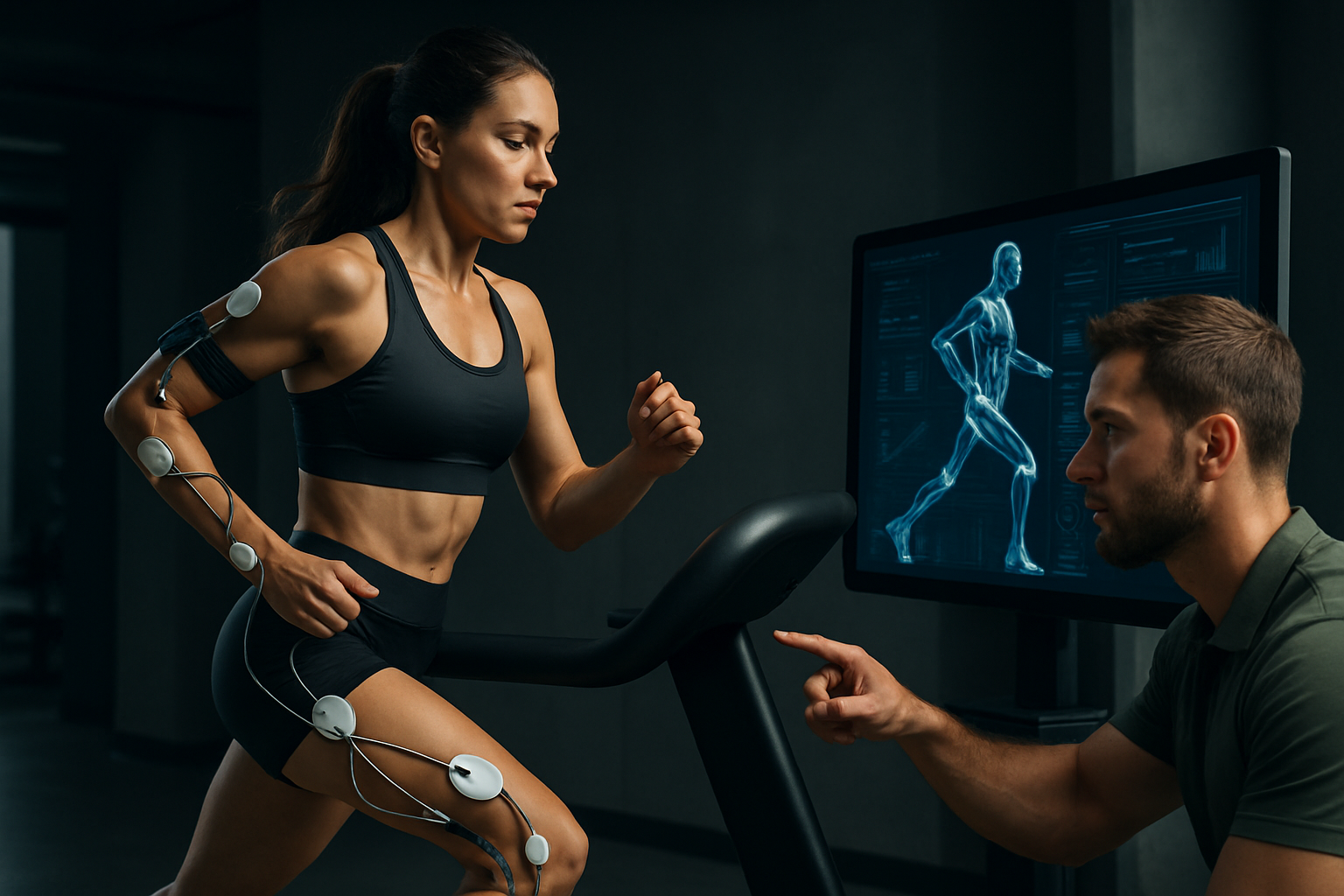Biohacking for Athletic Excellence: The Cutting Edge of Sports Performance
In the relentless pursuit of athletic supremacy, a new frontier has emerged: biohacking. This avant-garde approach to optimizing human performance is revolutionizing the way athletes train, recover, and compete. By leveraging cutting-edge science and technology, biohacking promises to unlock hidden potential and push the boundaries of human capabilities. From genetic testing to neurofeedback, the world of sports is witnessing a paradigm shift that could redefine what it means to be an elite athlete.

The concept of biohacking in sports isn’t entirely new. For decades, athletes have been experimenting with nutrition, training regimens, and recovery methods to enhance their performance. However, the current wave of biohacking takes this experimentation to unprecedented levels, incorporating advanced technologies and scientific methodologies that were previously inaccessible or unknown.
One of the pioneers in this field is Dave Asprey, the founder of Bulletproof and a well-known biohacker. While not an athlete himself, Asprey’s work has influenced many in the sports world. His emphasis on optimizing mitochondrial function, hormonal balance, and cognitive performance has resonated with athletes looking to maximize their potential.
Genetic Testing and Personalized Training
At the forefront of biohacking in sports is genetic testing. By analyzing an athlete’s DNA, trainers and nutritionists can develop highly personalized training and nutrition plans. This approach moves beyond the one-size-fits-all model, tailoring strategies to an individual’s genetic predispositions.
Companies like 23andMe and FitnessGenes offer genetic testing specifically for athletic performance. These tests can reveal information about an individual’s muscle fiber composition, recovery ability, and susceptibility to certain injuries. Armed with this knowledge, athletes can make informed decisions about their training intensity, recovery protocols, and even which sports they’re genetically predisposed to excel in.
For instance, the ACTN3 gene, often called the “speed gene,” is associated with fast-twitch muscle fibers. Athletes with certain variants of this gene may have a natural advantage in explosive, power-based sports. Conversely, those lacking this variant might be better suited for endurance events. By understanding their genetic makeup, athletes can focus on sports that align with their innate strengths.
However, it’s crucial to note that genetics is just one piece of the puzzle. Environmental factors, training, and nutrition still play significant roles in athletic success. Genetic testing should be viewed as a tool for optimization rather than a determinant of potential.
Neurofeedback and Brain Training
The brain, often overlooked in traditional athletic training, is now recognized as a crucial component in sports performance. Neurofeedback, a type of biofeedback that provides real-time information about brain activity, is gaining traction among elite athletes.
This technology allows athletes to visualize their brain activity and learn to control certain brainwaves associated with focus, relaxation, and peak performance. By training the brain to enter optimal states for competition, athletes can potentially improve their reaction times, decision-making abilities, and mental resilience.
The USA Olympic team has been at the forefront of adopting neurofeedback technology. Prior to the 2016 Rio Olympics, several American athletes incorporated neurofeedback into their training regimens. The technology was used to help athletes maintain focus under pressure and recover more quickly from mental fatigue.
One notable success story is that of Canadian tennis player Bianca Andreescu. She credits neurofeedback as a key factor in her upset victory over Serena Williams in the 2019 US Open final. Andreescu used visualization techniques and mental training, supported by neurofeedback, to maintain her composure during high-pressure moments.
While the efficacy of neurofeedback in sports is still being studied, early results are promising. As the technology becomes more accessible and refined, it’s likely to become a standard tool in an athlete’s mental training arsenal.
Wearable Technology and Continuous Monitoring
The advent of sophisticated wearable technology has revolutionized how athletes track and analyze their performance. From simple step counters to advanced biometric sensors, these devices provide a wealth of data that can be used to optimize training and recovery.
Advanced wearables can monitor heart rate variability (HRV), sleep quality, respiratory rate, and even blood oxygen levels. This continuous stream of data allows athletes and their coaches to make real-time adjustments to training intensity and recovery protocols.
One company at the forefront of this technology is WHOOP. Their wearable strap provides athletes with detailed insights into their strain (a measure of cardiovascular load), recovery, and sleep quality. The NBA has partnered with WHOOP to provide players with these devices, allowing them to make data-driven decisions about their training and recovery.
Another innovative wearable is the Oura Ring, which focuses on sleep tracking and recovery. By monitoring body temperature, respiratory rate, and heart rate, the ring provides a detailed analysis of sleep quality and readiness for physical activity. Several NFL players have incorporated the Oura Ring into their training regimens to optimize their recovery and performance.
The continuous monitoring provided by these devices allows for a level of precision in training that was previously impossible. Athletes can now tailor their workouts based on their body’s readiness, potentially reducing the risk of overtraining and injury while maximizing performance gains.
Nutrition and Supplementation: Beyond Macros and Micros
Nutrition has always been a crucial aspect of athletic performance, but biohacking takes it to a new level. Moving beyond simple calorie counting and macronutrient ratios, athletes are now exploring advanced nutritional strategies to optimize their biology.
One area of focus is the gut microbiome. Research has shown that the composition of gut bacteria can significantly impact athletic performance, influencing everything from energy metabolism to inflammation. Some athletes are now using specialized probiotics and prebiotics to cultivate a microbiome that supports their athletic goals.
Intermittent fasting is another nutritional strategy gaining popularity among athletes. By manipulating feeding windows, athletes aim to improve metabolic flexibility, enhance cognitive function, and potentially increase longevity. While the benefits of intermittent fasting for athletes are still being studied, many report improved energy levels and recovery times.
Supplementation has also evolved beyond basic vitamins and protein powders. Nootropics, substances that claim to enhance cognitive function, are being explored by athletes looking to improve mental performance. Compounds like creatine, traditionally used for muscle growth, are now being studied for their potential cognitive benefits as well.
Exogenous ketones are another cutting-edge supplement gaining traction in the athletic community. These supplements aim to induce a state of ketosis without the need for strict dietary restrictions. Some athletes report improved endurance and mental clarity when using exogenous ketones, although more research is needed to confirm these effects.
It’s important to note that while these nutritional strategies show promise, they should be approached with caution. What works for one athlete may not work for another, and some supplements can have potential side effects or interactions with medications.
Cryotherapy and Heat Exposure: Harnessing Temperature for Performance
Temperature manipulation has emerged as a powerful tool in the biohacker’s arsenal. Both extreme cold and heat exposure are being used to stimulate various physiological responses that can benefit athletic performance.
Cryotherapy, the use of extreme cold temperatures for therapeutic purposes, has gained popularity among athletes for its potential to reduce inflammation and accelerate recovery. Whole-body cryotherapy chambers, which expose the body to temperatures as low as -200°F for short periods, are now common in many professional sports facilities.
The purported benefits of cryotherapy include reduced muscle soreness, improved recovery times, and enhanced overall well-being. While scientific evidence is still mixed, many athletes swear by the practice. NBA star LeBron James is known to be a regular user of cryotherapy, crediting it for his longevity and ability to recover quickly between games.
On the other end of the spectrum, heat exposure through saunas and hot yoga is also being utilized for performance enhancement. Regular sauna use has been associated with improved cardiovascular function, increased heat tolerance, and even potential gains in endurance performance.
A study published in the Journal of Science and Medicine in Sport found that post-exercise sauna bathing could increase running endurance by up to 32%. The heat stress is thought to trigger various adaptations, including increased plasma volume and improved thermoregulation.
Some athletes are taking this concept further by incorporating contrast therapy – alternating between hot and cold exposures. This practice, sometimes called “environmental conditioning,” is believed to improve circulation, boost the immune system, and enhance recovery.
Sleep Optimization: The Final Frontier of Recovery
While often overlooked, sleep is perhaps the most crucial aspect of athletic recovery and performance. Biohackers are now applying scientific principles to optimize sleep quality and quantity.
Advanced sleep tracking devices, such as the aforementioned Oura Ring, provide detailed insights into sleep architecture, including time spent in various sleep stages. This data allows athletes to make informed decisions about their sleep habits and environment.
Light exposure plays a critical role in regulating the circadian rhythm. Many athletes are now using blue light-blocking glasses in the evening to promote melatonin production and improve sleep quality. Conversely, exposure to bright light in the morning can help reset the circadian clock and improve alertness.
Some athletes are experimenting with sleep cycles beyond the traditional 8-hour nightly sleep. Polyphasic sleep patterns, which involve multiple shorter sleep periods throughout the day, are being explored by some endurance athletes and ultra-competitors. While controversial and not suitable for everyone, proponents claim improved cognitive function and increased waking hours for training.
Temperature regulation during sleep is another area of focus. Devices like the ChiliPad allow precise control of bed temperature, which can significantly impact sleep quality. Many people sleep better in cooler environments, and maintaining an optimal sleep temperature throughout the night can lead to more restorative sleep.
Meditation and Mindfulness: The Mental Edge
The importance of mental preparation in sports has long been recognized, but biohacking approaches are bringing new techniques and technologies to this aspect of training.
Meditation and mindfulness practices are being embraced by athletes across various sports. These techniques can help improve focus, reduce anxiety, and enhance overall well-being. Many professional teams now incorporate meditation sessions into their training regimens.
NBA player Klay Thompson is known for his pre-game meditation routine, which he credits for his ability to stay calm under pressure. The Seattle Seahawks football team has also been at the forefront of incorporating mindfulness practices, with head coach Pete Carroll bringing in mindfulness experts to work with the team.
Technology is also playing a role in mental training. Apps like Headspace and Calm provide guided meditations specifically designed for athletes. More advanced tools, such as the Muse headband, use EEG sensors to provide real-time feedback during meditation, helping users develop their practice more quickly.
Virtual reality (VR) is another emerging technology being used for mental training. VR simulations can help athletes visualize success, practice specific scenarios, and even work on overcoming performance anxiety. This immersive approach to mental preparation is particularly useful for sports with high-pressure moments, such as golf or free-throw shooting in basketball.
Biofeedback and Heart Rate Variability Training
Biofeedback, the process of gaining awareness of physiological functions, is being used by athletes to improve their control over typically involuntary bodily processes. One particularly promising area is heart rate variability (HRV) training.
HRV, which measures the variation in time between heartbeats, is considered a marker of overall health and resilience. Higher HRV is generally associated with better stress tolerance and recovery capacity. By training to improve HRV, athletes aim to enhance their ability to perform under pressure and recover more efficiently.
Devices like the EmWave2 and Inner Balance allow athletes to visualize their HRV in real-time and practice techniques to improve it. These exercises often involve controlled breathing and cognitive techniques to induce a state of coherence between the heart and brain.
Some studies have shown that regular HRV training can lead to improvements in athletic performance, particularly in sports that require fine motor control and decision-making under pressure. Golfers, archers, and shooters have reported benefits from incorporating HRV training into their routines.
Oxygen Manipulation and Altitude Training
Manipulating oxygen levels has long been a strategy for endurance athletes, traditionally through altitude training. However, new technologies are making oxygen manipulation more accessible and precise.
Hypoxic training, which involves exercising in oxygen-reduced environments, can now be done at sea level using specialized equipment. Hypoxic tents and masks allow athletes to simulate high-altitude conditions, potentially stimulating the production of red blood cells and improving oxygen utilization.
Conversely, hyperoxic training, which involves breathing oxygen-enriched air during exercise, is being explored for its potential to enhance recovery and performance. Some studies suggest that brief exposures to hyperoxic conditions during high-intensity interval training can lead to greater improvements in VO2 max and endurance performance.
Intermittent hypoxic training (IHT), which alternates between normal and reduced oxygen levels, is another technique gaining popularity. This method aims to provide the benefits of altitude training without the prolonged exposure, making it more practical for many athletes.
While these oxygen manipulation techniques show promise, it’s crucial to note that they should be used under professional supervision. Improper use can lead to adverse effects and potentially dangerous situations.
Electrical Stimulation and Transcranial Direct Current Stimulation
The use of electrical stimulation in sports performance is an emerging and somewhat controversial area of biohacking. Two main approaches are being explored: neuromuscular electrical stimulation (NMES) and transcranial direct current stimulation (tDCS).
NMES involves applying electrical currents to muscles to induce contractions. This technique is being used to enhance strength training, accelerate recovery, and even maintain muscle mass during periods of inactivity (such as injury recovery). Some studies have shown that NMES can lead to strength gains comparable to traditional resistance training, particularly when combined with voluntary contractions.
tDCS, on the other hand, involves applying weak electrical currents to specific areas of the brain to modulate neural activity. This technique is being explored for its potential to enhance motor learning, improve focus, and even boost endurance performance.
A study published in the journal Brain Stimulation found that tDCS applied to the motor cortex during endurance training led to significant improvements in time to exhaustion. The researchers suggested that tDCS might enhance the brain’s ability to resist fatigue signals from the body.
While these electrical stimulation techniques show promise, they are still in the early stages of research. The long-term effects and optimal protocols are not yet fully understood, and athletes should approach these methods with caution and under professional guidance.
Conclusion: The Future of Biohacking in Sports
As we’ve explored, biohacking is pushing the boundaries of what’s possible in athletic performance. From genetic insights to brain training, from advanced wearables to cutting-edge nutritional strategies, athletes now have an unprecedented array of tools at their disposal to optimize their bodies and minds.
However, it’s important to approach biohacking with a balanced perspective. While these techniques offer exciting possibilities, they are not magic solutions. The fundamentals of proper training, nutrition, and recovery remain crucial. Biohacking should be seen as a complement to, not a replacement for, these foundational principles.
Moreover, as with any emerging field, there are potential risks and ethical considerations to be addressed. The long-term effects of some biohacking techniques are not yet fully understood, and there’s a fine line between performance optimization and unfair advantage.
As biohacking continues to evolve, it will likely become increasingly integrated into mainstream sports training. We may see more personalized approaches to athlete development, with training programs tailored to an individual’s genetic profile, physiological responses, and cognitive patterns.
The future of sports performance may well be a synthesis of cutting-edge technology, advanced scientific understanding, and the timeless human drive to push the limits of physical and mental capability. As biohacking opens new frontiers in athletic excellence, it promises to redefine our understanding of human potential and the nature of peak performance.
For athletes, coaches, and sports enthusiasts alike, staying informed about these developments will be crucial. The world of biohacking in sports is rapidly evolving, and those who can effectively integrate these new approaches may find themselves at the forefront of athletic innovation.
As we look to the future, one thing is clear: the intersection of biology, technology, and human performance will continue to reshape the landscape of competitive sports. The athletes of tomorrow will not only be training their bodies but optimizing their entire biological systems in the pursuit of excellence. The era of the biohacked athlete has arrived, and its full potential is yet to be realized.





